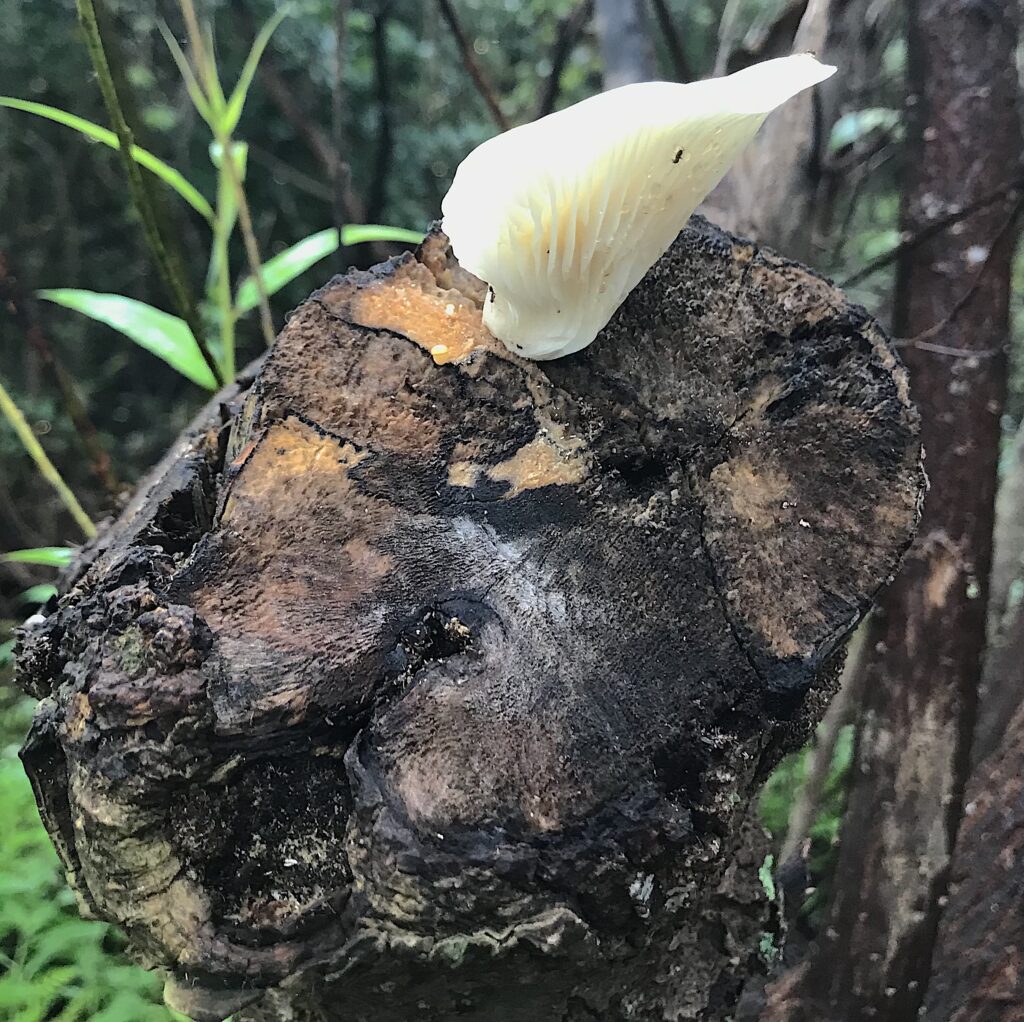
Oyster mushroom growing on a Sweet Bay. Photo by Green Deane
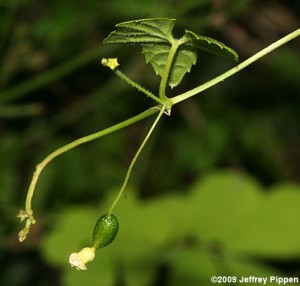
Creeping Cucumber keeps fruiting in south Florida.
Perhaps it was a last seasonal hurrah, or maybe the creatures that eat Melothria Pendula are full now (see photo right.) We found dozens of “mouse cucumbers” during our Saturday class in Winter Park. Perhaps the birds who like them have migrated. We had more than enough for several salads. Another surprise were oyster mushrooms growing on a Magnolia virginiana. It’s a good time of year for them but the lack of rain seem to not be a problem. A popular mushroom I have hundreds of plugs in various logs where I live.
Fraging Classes: We’re making a rare trip to an actual seaside class location Sunday and a bayside class Saturday
April 15th Saturday, Bayshore Live Oak Park, Bayshore Drive. Port Charlotte, meet in the parking lot at Bayshore and Ganyard. 9 a.m. to noon
APril 16th Sunday, Lori Wilson Park, 1500 N Atlantic Ave, Cocoa Beach, FL 32931, meet at the bathrooms, north side, 9 a.m. to noon.
April 22nd, Saturday, George LeStrange Preserve, 4911 Ralls Road, Fort Pierce, FL, 34981, 9 a.m. to noon.
Bring cash on the day of class or click here to pay for your class

Tall Evening Primrose (oenothera biennis) a “lost vegetable.”
Is it edible? The quick answer is no… maybe…. yes? The plant in question is the moth-pollenated Evening Primrose (whose blossoms open sunset to sunrise.) We have three species in locally, two are considered edible, the third is up in the air. Oenothera biennis is called a “lost vegetable.” It was cultivated in the area of Germany for about a century. The cooked root is edible, shoots raw or more often cooked, flowers in salads or pickled. Young pods steamed. There are two cultivars, EP 10 and Saguin. It’s the Evening Primrose I grew up with in Maine, a rather tall plant for a root vegetable, one to two yards high. It supposedly grows in central and North Florida but I have never seen it locally. It’s listed in most of North America except Idaho, Colorado, Utah, Arizona and Wyoming. The big debate is whether the plant is native to North America or is European. The other edible Evening Primrose locally is O. fruticosa, also called the “Wild Beet.” Natives parboiled the leaves then cooked them in grease. No mention of the root. Its seed capsules are club shaped. The primrose I see most often, however, is the “non-edible” low-growing O. laciniata aka Cutleaf Evening primrose. It is also the most common and has round seeds and short petals, an inch or less.
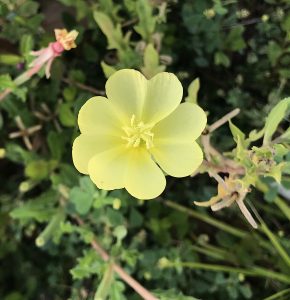
Cutleaf Primrose blossom. Photo by Green Deane
Many years ago I asked Forager Emeritus Dick Deuerling if O. laciniata was edible and he flatly said “no.” But on consideration texture and or palatability was important to Dick and he could have said no because he didn’t like to eat the plant. He felt that way about Burnweed (Erechtites hieraciifloius.) He was well-known for saying while there are a lot of edible wild plants “But I only eat the good stuff.” The Florida Native Plant Society says the seeds and leaves of the Cutleaf Evening Primrose were used as food and medicine by the Cherokee. It is not mentioned in Cornucopia II or Moerman’s Native American Food Plants. To make things complicated there are 16 “evening primroses” in Florida, 11 native. I have tasted one blossom of the Cutleaf but not yet consumed one (I had a long, awful illness after tasting a Tropical Sage blossom once [Salvia coccinea.] My blossom-experimenting days are behind me.)
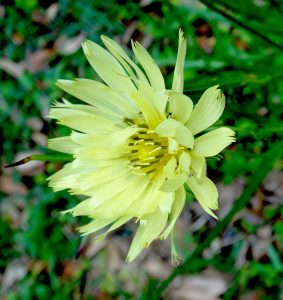
Dark stamens helps to identify this False Dandelion. Photo by Green Deane
Also seen this week was one of the “False Dandelions’ Hypochaeris radicata. In general terms there are four species known as False Dandelions (not counting species falsely called False Dandelion such as Crepis japonica.) There are at least three genera: Pyrrhopappus, Hypochaeris and Agoseris. Pyrrhopappus carolinianus are found in the southern eastern quarter of the United States. Hypochaeris radicata is found in most of North America except the high plains states. Hypochaeris glabra is some eastern states, some southern states, and some western states. Spotty. Agoseris aurantiaca is in the western U.S. and Canada and eastern Canada but not in between. Also note that Hypochaeris is also spelled Hypochoeris. In general terms False Dandelions are used like Dandelions though they do vary in flavor with H. radicata being quite bitter. The odd-one out is A. aurantiaca which has an orange-red blossom instead of yellow. You can read about them here.
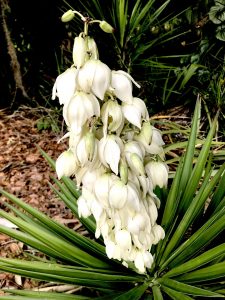
Also blossoming right now is our local yucca. Photo by Green Deane
Also blossoming now are our local yucca, Yucca filamentosa. While some wild edibles are under-rated perhaps the Yucca is over-rated. You will read in many foraging books that the blossoms are edible raw. Good luck with that. I have never found that so with our local species. Raw they have a wonderful texture and initial flavor but then a natural soap kicks in and leaves a bitter aftertaste that is quite disappointing. Cooked flowers, however, are quite tasty though you always have to knock out a lot of insects before cooking… well, you don’t really if you want some extra protein. I usually boil the blossoms. The flower spike is also edible when very young. Other parts are famine food. To read more about the yucca go here.

You get the USB, not the key.
My nine-DVD set of 135 videos has been phased out and replaced by 171-videos on a 128-GB USB, see right. The USB videos are the same videos I have on You Tube. Some people like to have their own copy especially if social order falters. The USB videos have to be copied to your computer to play. If you want to order the USB go to the DVD/USB order button on the top right of this page or click here. That will take you to an order form. Or you can make a $99 donation, which tells me it is for the USB (include a snail-mail address.) I’d like to thank all of you who ordered the DVD set over the years which required me to burn over 5,000 DVDs individually. I had to stop making them as few programs now will read the ISO files to copy them. Burning a set also took about three hours.

Green Deane Forum
Want to identify a plant? Perhaps you’re looking for a foraging reference? You might have a UFO, an Unidentified Flowering Object, you want identified. On the Green Deane Forum we — including Green Deane and others from around the world — chat about foraging all year. And it’s not just about warm-weather plants or just North American flora. Many nations share common weeds so there’s a lot to talk about. There’s also more than weeds. The reference section has information for foraging around the world. There are also articles on food preservation, and forgotten skills from making bows to fermenting food. Recent topics include: Stale Bread and Cod Liver Oil, Killing Bugs with Tobacco Plugs, Eating weeds: Is it safe? Have they mutated? Not the Eastern Red Bug but the Pink Tabebuia, African Tulip Tree, Asparagus densiflorus, Green Deane’s Book… You can join the forum by clicking on the button on the upper right hand side of this page.
This is my weekly newsletter #553. If you want to subscribe to this free newsletter you can find the sign-up form in the menu at the top of the page. My website, EatTheWeeds.com, which is data secure, has over 1500 plants on it in some 428 articles. I wrote every one myself, no cut and paste.
To donate to the Green Deane Newsletter click here.

